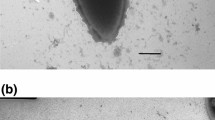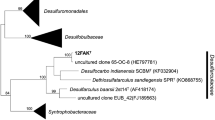Abstract
A hyperthermophilic heterotrophic archaeon (strain WB1) was isolated from a thermal pool in the Washburn hot spring group of Yellowstone National Park, USA. WB1 is a coccus, 0.6–1.2 μm in diameter, with a tetragonal S-layer, vacuoles, and occasional stalk-like protrusions. Growth is optimal at 84°C (range 64–93°C), pH 5–6 (range 3.5–8.5), and <1 g/l NaCl (range 0–4.6 g/l NaCl). Tests of metabolic properties show the isolate to be a strict anaerobe that ferments complex organic substrates. Phylogenetic analysis of the 16S rRNA gene sequence places WB1 in a clade of previously uncultured Desulfurococcaceae and shows it to have ≤96% 16S rRNA sequence identity to Desulfurococcus mobilis, Staphylothermus marinus, Staphylothermus hellenicus, and Sulfophobococcus zilligii. The 16S rRNA gene contains a large insertion similar to homing endonuclease introns reported in Thermoproteus and Pyrobaculum species. Growth is unaffected by the presence of S0 or SO4 2−, thereby differentiating the isolate from its closest relatives. Based on phylogenetic and physiological differences, it is proposed that isolate WB1 represents the type strain of a novel genus and species within the Desulfurococcaceae, Thermogladius shockii gen. nov., sp. nov. (RIKEN = JCM-16579, ATCC = BAA-1607, Genbank 16S rRNA gene = EU183120).




Similar content being viewed by others
References
Barns SM, Fundyga RE, Jeffries MW, Pace NR (1994) Remarkable archaeal diversity detected in a Yellowstone National Park hot spring environment. PNAS 91:1609–1613
Brock TD, Freeze H (1969) Thermus aquaticus gen. nov. and sp. nov., a nonsporulating extreme thermophile. J Bacteriol 98:289–297
Burggraf S, Larsen N, Woese CR, Stetter KO (1993) An intron within the 16S ribosomal RNA gene of the archaeon Pyrobaculum aerophilum. PNAS 90:2547–2550
DeLong EF (1992) Archaea in coastal marine environments. PNAS 89:5685
Fiala G, Stetter KO, Jannasch HW, Langworthy TA, Madon J (1986) Staphylothermus marinus sp. nov. represents a novel genus of extremely thermophilic submarine heterotrophic archaebacteria growing up to 98°C. Syst Appl Microbiol 8:106–113
Gonin M, Quardokus EM, O’Donnol D, Maddock J, Brun YV (2000) Regulation of stalk elongation by phosphate in Caulobacter crescentus. J Bacteriol 182:337–347
Hanada S, Takaichi S, Matsuura K, Nakamura K (2002) Roseiflexus castenholzii gen. nov., sp. nov., a thermophilic, filamentous, photosynthetic bacterium that lacks chlorosomes. Int J Syst Evol Microbiol 52:187
Hensel R et al (1997) Sulfophobococcus zilligii gen. nov., spec. nov. a novel hyperthermophic archaeum isolated from hot alkaline springs of Iceland. Syst Appl Microbiol 20:102–110
Huber R, Dyba D, Huber H, Burggraf S, Rachel R (1998a) Sulfur-inhibited Thermosphaera aggregans sp. nov., a new genus of hyperthermophilic archaea isolated after its prediction from environmentally derived 16S rRNA sequences. Int J Syst Evol Microbiol 48:31–38
Huber R et al (1998b) Thermocrinis ruber gen. nov., sp. nov., a pink-filament-forming hyperthermophilic bacterium isolated from Yellowstone National Park. Appl Environ Microbiol 64:3576–3583
Huber H, Burggraf S, Mayer T, Wyschkony I, Rachel R, Stetter K (2000) Ignicoccus gen. nov., a novel genus of hyperthermophilic, chemolithoautotrophic Archaea, represented by two new species, Ignicoccus islandicus sp. nov. and Ignicoccus pacificus sp. nov. Int J Syst Evol Microbiol 50:2093–2100
Hugenholtz P, Pitulle C, Hershberger KL, Pace NR (1998) Novel division level bacterial diversity in a Yellowstone hotspring. J Bacteriol 180:366–376
Itoh T, Nomura N, Sako Y (2003) Distibution of 16S rRNA introns among the family Thermoproteaceae and their evolutionary implications. Extremophiles 7:229–233
Korf SE, Inskeep WP, Macur RE, Kozubal MA, Taylor WP, Nagy A (2006) Microbial population distribution at Norris Geyser Basin in Yellowstone National Park. In: Land Resources and Environmental Science, Montana State University, 815 Leon Johnson Hall, Bozeman, MT 59717, USA
Kozubal MA et al (2008) Isolation and distribution of a novel iron-oxidizing crenarchaeon from acidic geothermal springs in Yellowstone National Park. Appl Environ Microbiol 74:942–949
Lykke-Anderson J, Thi-Ngoc HP, Garret RA (1994) DNA substrate specificity and cleavage kinetics of an archaeal homing-type endonuclease from Pyrobaculum organotrophum. Nucleic Acids Res 22:4583–4590
Meyer-Dombard DR, Shock EL, Amend JP (2005) Archaeal and bacterial communities in geochemically diverse hot springs of Yellowstone National Park, USA. Geobiology 3:211–227
Nakagawa S, Shtaih Z, Banta A, Beveridge TJ, Sako Y, Reysenbach A (2005) Sulfurihydrogenibium yellowstonense sp. nov., an extremely thermophilic, facultatively heterotrophic, sulfur-oxidizing bacterium from Yellowstone National Park, and emended descriptions of the genus Sulfurihydrogenibium, Sulfurihydrogenibium subterraneum and Sulfurihydrogenibium azorense. Int J Syst Evol Microbiol 55:2263–2268
Sako Y et al (1996) Aeropyrum pernix gen. nov., sp. nov., a novel aerobic hyperthermophilic archaeon growing at temperatures up to 100°C. Int J Syst Bacteriol 46:1070–1077
Sorensen KB, Lauer A, Teske A (2004) Archaeal phylotypes in a metal-rich and low-activity deep subsurface sediment of the Peru Basin, ODP Leg 201, Site 1231. Geobiology 2:151
Spear JR, Walker JJ, McCollom TM, Pace NR (2005) Hydrogen and bioenergetics in the Yellowstone geothermal ecosystem. PNAS 102:2555–2560
Stohr R, Waberski A, Liesack W, Volker H, Wehmeyer U, Thomm M (2001) Hydrogenophilus hirschii sp. nov., a novel thermophilic hydrogen-oxidizing beta-proteobacterium isolated from Yellowstone National Park. Int J Syst Evol Microbiol 51:481–488
Ward DM, Santegoeds CM, Nold SC, Ramsing NB, Ferris MJ, Bateson MM (1997) Biodiversity within hot spring microbial mat communities: molecular monitoring of enrichment cultures. Antonie van Leeuwenhoek 71:143–150
Wildhaber I, Santarius U, Baumeister W (1987) Three-dimensional structure of the surface protein of Desulfurococcus mobilis. J Bacteriol 169:5563–5568
Windman T, Zolotova N, Schwandner F, Shock EL (2007) Formate as an energy source for microbial metabolism in chemosynthetic zones of hydrothermal ecosystems. Astrobiology 7:873–889
Zillig W et al (1982) Desulfurococcaceae the second family of the extremely thermophilic, anaerobic, sulfur-respiring Thermoproteales. Zbl Bakt Hyg T Abt Orig 3:304–317
Zillig W et al (1990) Hyperthermus butylicus, a hyperthermophilic sulfur-reducing archaebacterium that ferments peptides. J Bacteriol 172:3959–3965
Acknowledgments
This work represents the senior author’s undergraduate honors thesis at Washington University in St. Louis. Funding to MRO was provided by a Hoopes Grant and a Grant from the Environmental Studies Program at Washington University and a NSF Graduate Research Fellowship. Funding to JPA was from NSF grant 0525500 and a fellowship from the Hanse Wissenschaftskolleg in Delmenhorst, Germany. Thanks are due to D’Arcy Meyer-Dombard and Everett Shock for help on field expeditions to YNP and to Darcy Gill and Wandy Beatty of the Washington University Molecular Microbiology Imaging Facility for assistance with TEM images. Samples were collected under the authority of Yellowstone NP Research Permit #5434.
Author information
Authors and Affiliations
Corresponding author
Additional information
Communicated by Erko Stackebrandt.
Electronic supplementary material
Below is the link to the electronic supplementary material.
203_2010_639_MOESM1_ESM.tif
Fig. S1: Additional phylogenetic tree of the selected member of the Desulfurococcales constructed using a neighbor joining method. GenBank accession numbers are given in parentheses and superscript T indicates type strain. (TIFF 3,587 kb)
Rights and permissions
About this article
Cite this article
Osburn, M.R., Amend, J.P. Thermogladius shockii gen. nov., sp. nov., a hyperthermophilic crenarchaeote from Yellowstone National Park, USA. Arch Microbiol 193, 45–52 (2011). https://doi.org/10.1007/s00203-010-0639-8
Received:
Revised:
Accepted:
Published:
Issue Date:
DOI: https://doi.org/10.1007/s00203-010-0639-8




